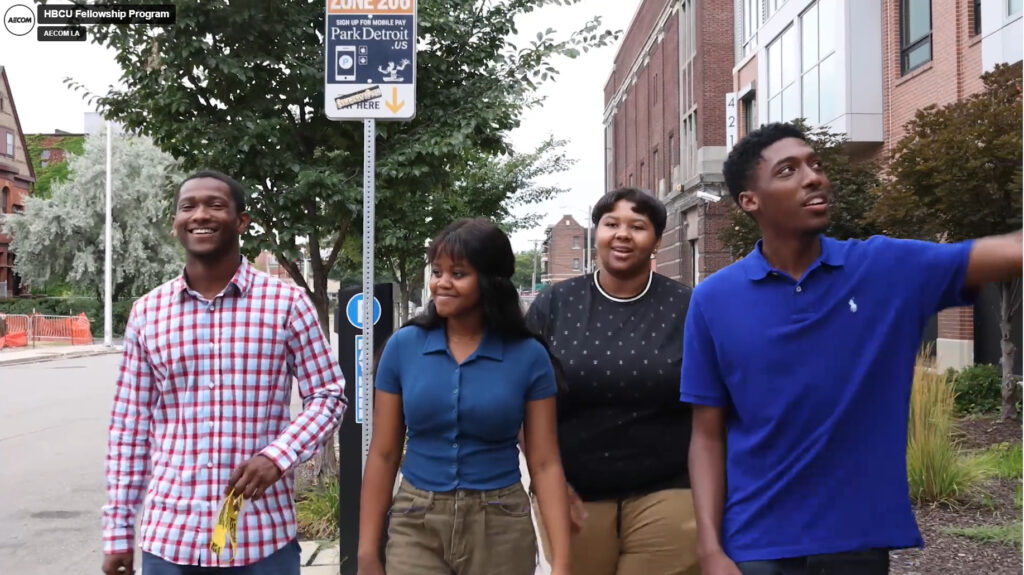A design fellowship opportunity transforms a Detroit community
As the world’s trusted infrastructure consulting firm, our environmental, social and governance (ESG) commitments are crucial to the work that we do. We strive towards delivering a better world by ensuring that we create social value for the communities we serve through our project work and operations.
Aligning with our commitment of diversity and inclusion in the workplace and beyond, this past summer, we proudly partnered with the Detroit Police Athletic League (PAL) on the Historically Black Colleges and Universities (HBCU) Design Fellowship. The Summer Design Fellowship hosted four HBCU students who developed design solutions for one of Detroit PAL’s pressing architectural challenges in the community. For nine weeks, they worked under the mentorship of AECOM’s industry best in Detroit to renovate PAL’s recreation center—originally known as the historic St. Andrews gym in southwest Detroit.
The proposed design adds much-needed community functions including an indoor running track, an updated basketball gym, a clinic and a computer lab for eSports. The four fellows share their thoughts on the fellowship and the impact it has left on them.

1. What was one big takeaway/lesson you learned this summer as an HBCU Fellow?
Apellonia Williams: A big takeaway I had was around the overall structure and timeline of the business. I noticed the differences between learning in studio and understanding how the design process works in the real world. I gained a deeper understanding of the infrastructure field and the steps involved to find the best design solutions.
Kevin Robinson: One thing that I have taken away from the HBCU Fellowship is being able to experience daily life in an actual workplace. I was able to network with colleagues, craft my abilities, and enhance my skills.
2. Based on your experience this summer, how do you see infrastructure benefiting communities like Detroit and organizations like PAL?
Atira Forrest: I believe infrastructure like the project we worked on in Detroit and in similar communities helps to build up the esteem of the areas involved. If you live somewhere surrounded by places that were unable to meet your needs, you might begin to feel neglected or misunderstood. However, when companies like AECOM work alongside the residents of these communities to create high-value spaces, it radically changes the environment. I believe these projects are important because they create beautiful, useful spaces that let the people using them know that they are seen, heard and respected.
Naylen Saunders: Improving the infrastructure of Detroit PAL Recreation Center was a gratifying experience. It helped me further realize that infrastructure is a key element in determining the quality of a community. It feels great to be a part of improving the infrastructure in Detroit. I hope to continue to work with companies that strive to put communities first and focus on improving the future of such areas.
3. Explain the project you worked on this summer. What was the most challenging part of the project? What was the most rewarding?
Atira Forrest: This summer, my colleagues and I took the historic St. Andrews Gymnasium and turned it into a space that fits the changing needs of its community. We thoroughly studied the building and its environment for weeks before designing, to ensure we came up with a building that worked for the people it would serve. The most challenging part of this project was finding solutions to the many problems we encountered by designing in the real world. In the studio, we could create freely without adhering to a strict budget, but with this project, every solution we proposed had to be calculated before it could be applied. It was frustrating, but overall, it made me a better architect. The most rewarding aspect was seeing everything come together at the end and watching proud smiles spread across the faces of our mentors and clients.
Naylen Saunders: We had the pleasure of working with Detroit PAL in developing their Recreation Center. Along with my colleagues, we delivered a design proposal for the renovation of PAL’s Recreation Center. The most challenging part was adapting to how the profession works on a project as well as meeting client deadlines. However, my colleagues and I were able to overcome that challenge. The most rewarding part was being able to work on a design solution that will impact my home area of Detroit.
4. Where do you see the experience gained from this fellowship taking you in the future?
Kevin Robinson: I see myself using my skills to progress my architectural career. I can also see myself at a workplace with similar or the same ideals as this firm.
Apellonia Williams: In the future, I would like to see myself leading or being a part of a design team working on similar projects where I can apply the ideas and strategies I learned during the internship. I also would like to continue the relationship with PAL and give back to the communities by volunteering my expertise.
This fellowship was made possible by our Detroit AECOM team—special thanks to Pierre Roberson, design principal, for his mentorship. Additionally, we are thankful for our partnership with Detroit PAL and the work that they continue to do for the city of Detroit.






